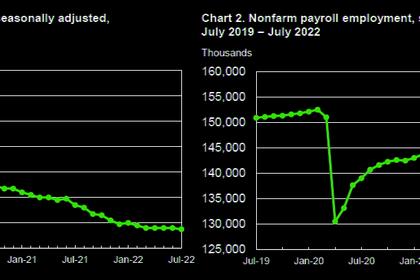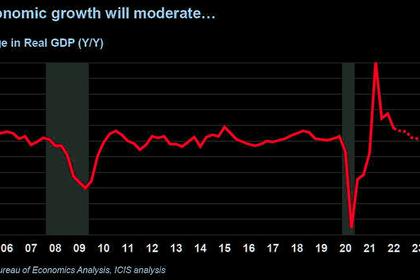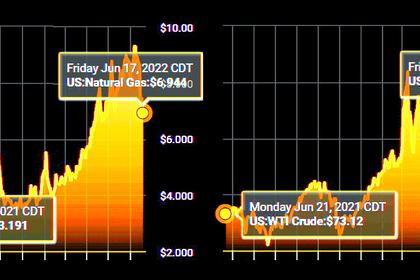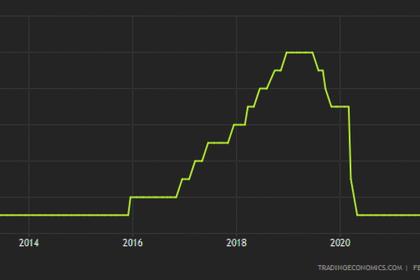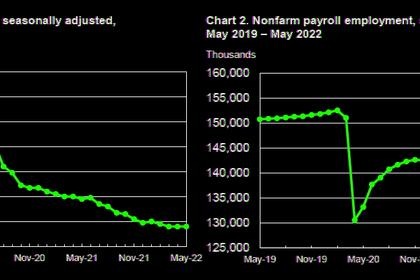
U.S. EMPLOYMENT UP BY 315,000
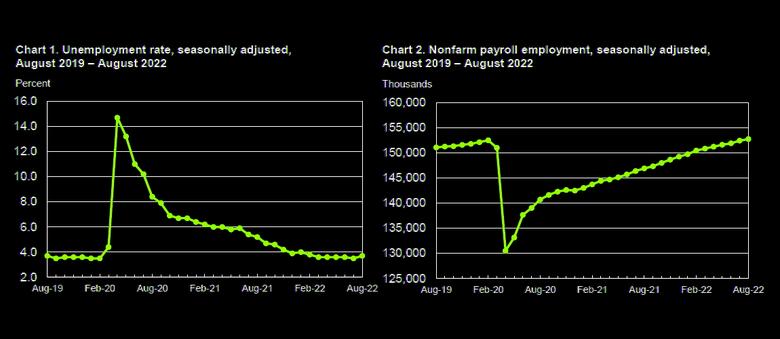
U.S. BLS - September 2, 2022 - THE EMPLOYMENT SITUATION—AUGUST 2022
Total nonfarm payroll employment increased by 315,000 in August, and the unemployment rate rose to 3.7 percent, the U.S. Bureau of Labor Statistics reported today. Notable job gains occurred in professional and business services, health care, and retail trade.
This news release presents statistics from two monthly surveys. The household survey measures labor force status, including unemployment, by demographic characteristics. The establishment survey measures nonfarm employment, hours, and earnings by industry. For more information about the concepts and statistical methodology used in these two surveys, see the Technical Note.
Household Survey Data
In August, the unemployment rate rose by 0.2 percentage point to 3.7 percent, and the number of unemployed persons increased by 344,000 to 6.0 million. In July, these measures had returned to their levels in February 2020, prior to the coronavirus (COVID-19) pandemic. (See table A-1.)
Among the major worker groups, the unemployment rates for adult men (3.5 percent) and Hispanics (4.5 percent) rose in August. The jobless rates for adult women (3.3 percent), teenagers (10.4 percent), Whites (3.2 percent), Blacks (6.4 percent), and Asians (2.8 percent) showed little change over the month. (See tables A-1, A-2, and A-3.)
Among the unemployed, the number of permanent job losers increased by 188,000 to 1.4 million in August. The number of persons on temporary layoff was virtually unchanged at 782,000. (See table A- 11.)
The number of long-term unemployed (those jobless for 27 weeks or more) was little changed at 1.1 million in August. The long-term unemployed accounted for 18.8 percent of all unemployed persons. (See table A-12.)
The labor force participation rate increased by 0.3 percentage point over the month to 62.4 percent but is 1.0 percentage point below its February 2020 level. The employment-population ratio was little changed at 60.1 percent in August and remains 1.1 percentage points below its February 2020 value. (See table A-1.)
The number of persons employed part time for economic reasons was little changed at 4.1 million in August. These individuals, who would have preferred full-time employment, were working part time because their hours had been reduced or they were unable to find full-time jobs. (See table A-8.) The number of persons not in the labor force who currently want a job declined by 361,000 to 5.5 million in August. This measure remains above its February 2020 level of 5.0 million. These individuals were not counted as unemployed because they were not actively looking for work during the 4 weeks preceding the survey or were unavailable to take a job. (See table A-1.)
Among those not in the labor force who wanted a job, the number of persons marginally attached to the labor force, at 1.4 million, was little changed in August. These individuals wanted and were available for work and had looked for a job sometime in the prior 12 months but had not looked for work in the 4 weeks preceding the survey. Discouraged workers, a subset of the marginally attached who believed that no jobs were available for them, numbered 366,000 in August, little changed from the prior month. (See Summary table A.)
Household Survey Supplemental Data
In August, 6.5 percent of employed persons teleworked because of the coronavirus pandemic, down from 7.1 percent in the prior month. These data refer to employed persons who teleworked or worked at home for pay at some point in the 4 weeks preceding the survey specifically because of the pandemic.
In August, 1.9 million persons reported that they had been unable to work because their employer closed or lost business due to the pandemic—that is, they did not work at all or worked fewer hours at some point in the 4 weeks preceding the survey due to the pandemic. This measure is down from 2.2 million in the previous month. Among those who reported in August that they were unable to work because of pandemic-related closures or lost business, 21.5 percent received at least some pay from their employer for the hours not worked, little different from the previous month.
Among those not in the labor force in August, 523,000 persons were prevented from looking for work due to the pandemic, little changed from the prior month. (To be counted as unemployed, by definition, individuals must be either actively looking for work or on temporary layoff.)
These supplemental data come from questions added to the household survey in May 2020 to help gauge the effects of the pandemic on the labor market. The data are not seasonally adjusted. Tables with estimates from the supplemental questions for all months are available online at www.bls.gov/cps/effects-of-the-coronavirus-covid-19-pandemic.htm. (For more information about upcoming changes to these supplemental data, see the box note on page 4.)
Establishment Survey Data
Total nonfarm payroll employment increased by 315,000 in August. Nonfarm employment has risen by 5.8 million over the past 12 months, as the labor market continued to recover from the job losses of the pandemic-induced recession. This growth brings total nonfarm employment 240,000 higher than its pre-pandemic level in February 2020. In August, notable job gains occurred in professional and business services, health care, and retail trade. (See table B-1.)
Professional and business services added 68,000 jobs in August. Within the industry, employment gains occurred in computer systems design and related services (+14,000), management and technical consulting services (+13,000), architectural and engineering services (+10,000), and scientific research and development services (+6,000), while legal services lost jobs (-9,000). Over the past 12 months, professional and business services has added 1.1 million jobs.
In August, health care employment rose by 48,000, with job gains in offices of physicians (+15,000), hospitals (+15,000), and nursing and residential care facilities (+12,000). Health care has added 412,000 jobs over the year. Despite this growth, employment in health care is below its February 2020 level by 37,000, or 0.2 percent.
Retail trade added 44,000 jobs in August and 422,000 jobs over the past 12 months. In August, employment increased in general merchandise stores (+15,000), food and beverage stores (+15,000), health and personal care stores (+10,000), and building material and garden supply stores (+7,000).
Employment in furniture and home furnishings stores continued to trend down (-3,000).
Manufacturing employment continued to trend up in August (+22,000), with gains concentrated in durable goods industries (+19,000). Manufacturing has added 461,000 jobs over the year.
Employment in financial activities rose by 17,000 in August and by 200,000 over the year.
Employment in wholesale trade increased by 15,000 in August, returning to its February 2020 level.
This industry has added 197,000 jobs over the year.
Mining employment rose by 6,000 in August, reflecting a gain in support activities for mining (+7,000). Over the year, mining has added 68,000 jobs.
Employment in leisure and hospitality changed little in August (+31,000), following average monthly gains of 90,000 in the first 7 months of the year. Employment in leisure and hospitality is below its February 2020 level by 1.2 million, or 7.2 percent.
In August, employment showed little change in other major industries, including construction, transportation and warehousing, information, other services, and government.
In August, average hourly earnings for all employees on private nonfarm payrolls rose by 10 cents, or 0.3 percent, to $32.36. Over the past 12 months, average hourly earnings have increased by 5.2 percent.
In August, average hourly earnings of private-sector production and nonsupervisory employees rose by 10 cents, or 0.4 percent, to $27.68. (See tables B-3 and B-8.)
The average workweek for all employees on private nonfarm payrolls decreased by 0.1 hour to 34.5 hours in August. In manufacturing, the average workweek for all employees was little changed at 40.3 hours, and overtime held at 3.3 hours. The average workweek for production and nonsupervisory employees on private nonfarm payrolls declined by 0.1 hour to 33.9 hours. (See tables B-2 and B-7.)
The change in total nonfarm payroll employment for June was revised down by 105,000, from +398,000 to +293,000, and the change for July was revised down by 2,000, from +528,000 to +526,000. With these revisions, employment in June and July combined is 107,000 lower than previously reported.
(Monthly revisions result from additional reports received from businesses and government agencies since the last published estimates and from the recalculation of seasonal factors.)
-----
Earlier:
